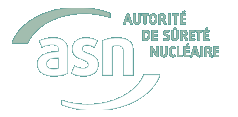| Chapter 14 |
- THE FRENCH ALTERNATIVE ENERGIES AND ATOMIC ENERGY
COMMISSION’S INSTALLATIONS
- Generic subjects
- Experience feedback from the Fukushima Daiichi accident
- Management of nuclear safety and radiation protection at CEA
- Monitoring of CEA’s compliance with its main nuclear safety and radiation protection commitments
- Periodic safety reviews
- Monitoring of sub-criticality
- Management of sealed sources of ionising radiation
- Revision of water intake and discharge licences
- Assessment of seismic hazards
- Management of civil engineering projects
- Research reactor cores and experimental systems
- Topical events in CEA research facilities
- CEA centres
- Research reactors
- Laboratories
- Fissile material stores
- The POSEIDON irradiator
- Waste and effluent storage and treatment facilities
- Installations undergoing decommissioning
- NON-CEA NUCLEAR RESEARCH INSTALLATIONS
- Large national heavy ion accelerator (GANIL)
- Laue-Langevin Institute (ILL) high flux reactor
- European organization for nuclear research (CERN) installations
- The ITER (international thermonuclear experimental reactor) project
- IONISERS, THE PRODUCTION OF RADIONUCLIDES FOR PHARMACEUTICAL
USE, THE MAINTENANCE UNITS AND THE OTHER NUCLEAR FACILITIES
- Industrial ionisation installations
- The radio-pharmaceutical production facility operated by CIS bio international
- Maintenance facilities
- Chinon irradiated material facility (AMI)
- Inter-regional fuel warehouses (MIR)
- INTERNATIONAL ACTIONS
- OUTLOOK
|
|
The research and other installations regulated by ASN differ
widely, but are usually small in size. ASN will continue to
concentrate on regulating the safety and radiation protection of
these installations as a whole and on comparing practices per
type of installation in order to choose the best ones and thus
encourage operating experience feedback.
It is in this spirit that ASN as defined priorities for the submittal
of the complementary safety assessments concerning the
nuclear facilities other than the power reactors. A prior analysis
was conducted to assess the risks in the light of the experience
feedback from the Fukushima Daiichi accident and the "potential
source term". In effect, given the diversity of the nuclear
fleet, each facility must be studied individually.
In 2012, over and beyond the follow-ups that will be given to
the complementary safety assessments received in 2011, ASN
will examine those for:
- 9 other CEA facilities (PÉGASE, CABRI, RAPSODIE, MCMF,
LECA, Cadarache storage yard, CHICADE, ORPHÉE,
ATALANTE);
- support functions on the Cadarache and Marcoule sites;
- the inter-regional fuel warehouses;
- ITER;
- CIS bio international installation.
Moreover, ASN considers that the "major commitments"
initiative implemented by the CEA over the last 4 years must be
continued and regularly expanded to include new "major
commitments". This system effectively allows targeted tracking
of priority actions, which have a clearly set deadlines. Any
extension to the deadline must therefore firstly be duly
justified, and secondly be discussed with ASN. Even though the
system can still be improved, and some deadlines have now
been pushed back significantly with respect to the initial due
dates, the results are globally positive. ASN will nevertheless
remain particularly vigilant and could, if necessary, take
decisions of a prescriptive nature.
In 2012 ASN will continue to pay particular attention to new
projects such as the JHR, the GANIL extension, the ITER
facility, and the restarting of the CABRI installation. It will also
be attentive to meeting deadlines for transfer of nuclear
materials stored in the MCMF, the EOLE and MINERVE
reactors, and MASURCA, to the new MAGENTA facility.
ASN will examine the conclusions of the periodic safety review
of the GANIL facility and of the CIS Bio International
installation in order to decide on the acceptability of mediumto
long-term continuation of their operation.
Moreover, in 2012, ASN will examine - via the examination of
the ASTRID prototype project and work on fourth-generation
"Generation IV" reactors (also see chapter 12) - the operating
experience feedback from the fast neutron reactors (PHÉNIX,
SUPERPHÉNIX and RAPSODIE, now shutdown), as well as the
information requested from the CEA/EDF/AREVA consortium
for comparison, in terms of safety, of the different systems. This
will be part of the preparatory work to enable ASN to adopt a
position at the end of 2012 on the interim report relative to the
possibilities of transferring the long-lived waste, provided for by
the "Waste act" of 28 June 2006.
Finally, in 2012 ASN will continue to promote international
harmonisation on the safety of research reactors. It will also
continue to be an active contributor to international reflection
into the aging of installations and the safety of supply of
radionuclides for medical use.
|




